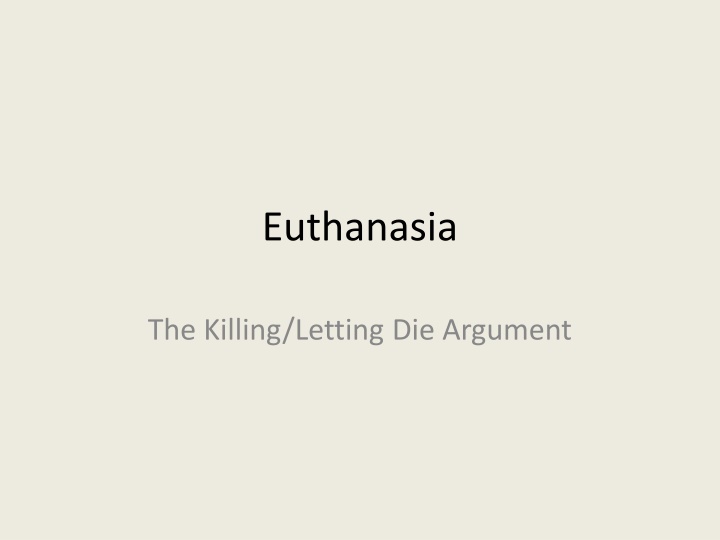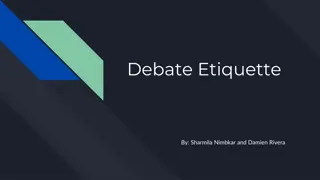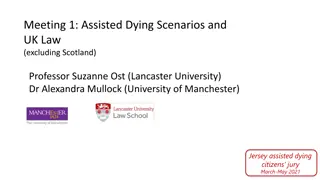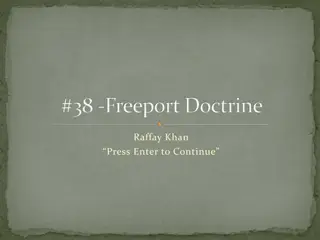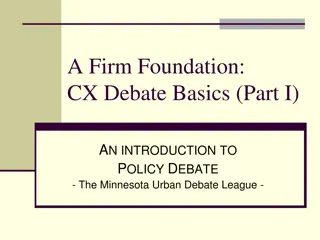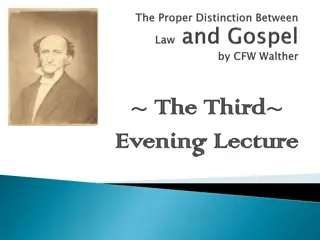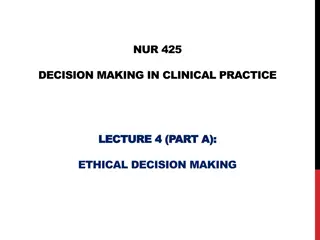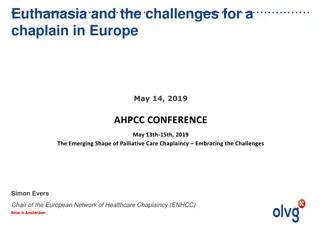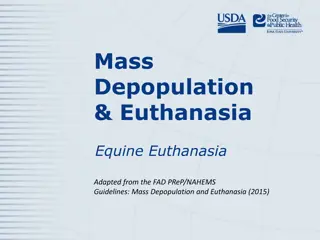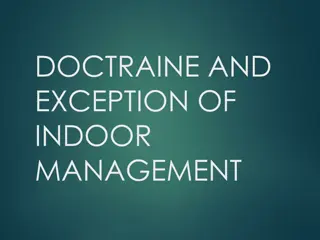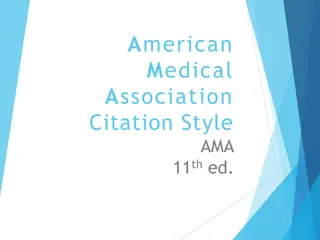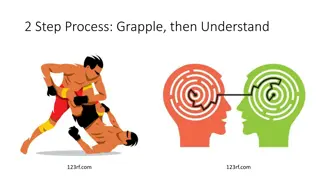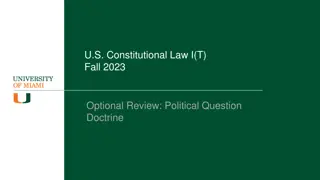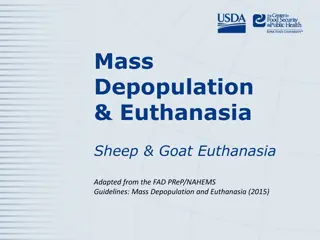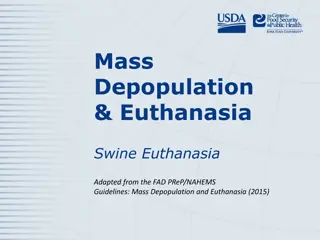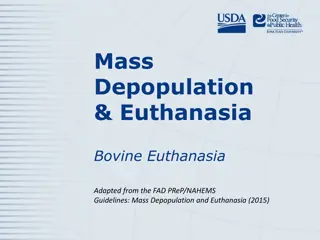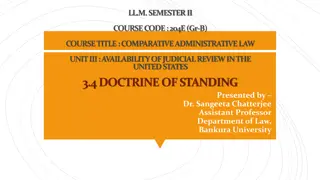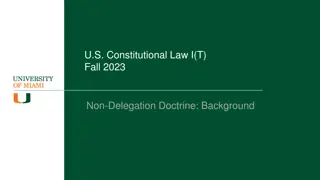Ethical Debate on Euthanasia: Rachels' Critique of AMA Doctrine
James Rachels challenges the American Medical Association's distinction between active and passive euthanasia, arguing that it lacks ethical justification. The AMA doctrine permits passive euthanasia but forbids active euthanasia, leading to potential prolonged suffering for terminally ill patients. A case study of a throat cancer patient highlights the ethical complexities of withholding treatment versus taking direct action to end suffering. The debate raises questions about compassion, autonomy, and the role of medical professionals in end-of-life care.
Download Presentation

Please find below an Image/Link to download the presentation.
The content on the website is provided AS IS for your information and personal use only. It may not be sold, licensed, or shared on other websites without obtaining consent from the author.If you encounter any issues during the download, it is possible that the publisher has removed the file from their server.
You are allowed to download the files provided on this website for personal or commercial use, subject to the condition that they are used lawfully. All files are the property of their respective owners.
The content on the website is provided AS IS for your information and personal use only. It may not be sold, licensed, or shared on other websites without obtaining consent from the author.
E N D
Presentation Transcript
Euthanasia The Killing/Letting Die Argument
James Rachels: Active and Passive Killing Rachels Project Rachels argues that the American Medical Association s distinction between active and passive killing is ethically unfounded. Note that Rachels paper was published in a medical journal, not a philosophical journal.
American Medical Association Doctrine: The intentional termination of the life of one human being by another mercy killing is contrary to that for which the medical profession stands and is contrary to the policy of the American Medical Association. The cessation of the employment of extraordinary means to prolong the life of the body when there is irrefutable evidence that biological death is imminent is the decision of the patient and/or his immediate family. The advice and judgment of the physician should be freely available to the patient and/or his immediate family. (pp. 289)
American Medical Association Doctrine: extraordinary means : any procedure or intervention which in the judgment of the attending physician would serve only to postpone artificially the moment of death. (North Carolina legal definition) imminent : within a week? within six months? According to Rachels: The AMA doctrine forbids active euthanasia . The AMA doctrine permits passive euthanasia .
Case 1: Throat Cancer Patient A patient is dying of incurable throat cancer, and is in terrible pain, which can no longer be alleviated. He is certain to die within a few days, even if present treatment is continued. But he does not want to go on living for those few days since the pain is unbearable. As such, the patient asks the doctor to put and end to it, and his family joins in the request.
Case 1: Throat Cancer Patient Suppose the doctor agrees to withhold treatment, as the AMA doctrine says he may. The justification for his doing so is that the patient is in terrible agony, and since he is going to die anyway, it would be wrong to prolong his suffering needlessly. But if one simply withholds treatment, it may take longer for the patient to die, and he is sure to suffer more than he would if direct action were taken in the form of a lethal injection. In this case, endorsing passive euthanasia over active euthanasia leads to more suffering, and this is in direct opposition to the humanitarian impulse that fuels the original decision not to prolong his life. The AMA doctrine is essentially cruel!
Case 2: Downs Syndrome Baby Some Down s syndrome babies are born with congenital defects, such as intestinal obstructions, which require surgery if they are to live. Intestinal surgery is relatively routine, but sometimes the parents and the doctor will decide not to operate, and to let the child die. Ultimately, the child will die of dehydration and infection over the course of hours or days. The AMA doctrine says that this is allowable, where giving the baby a lethal injection to end its life without suffering is not.
Case 2: Downs Syndrome Baby The AMA doctrine leads to life-and-death decisions made on irrelevant grounds. The reason that the relatively simple intestinal operations are not performed is clearly that the child has Down s syndrome, and the parents and doctor judge that because of that, it is better to let the child die. But it is the intestinal obstruction and not the Down s syndrome that risks killing the child. The issue of the intestinal blockage is essentially irrelevant to the issue of why the parents are letting the child die. According to this way of thinking, if there is an intestinal blockage, it is permissible to let the child die, but if there were no such blockage, one must not kill it. Surely that it leads to such life-and-death decisions made on irrelevant grounds is a strike against the AMA doctrine!
Smith & Jones Thought Experiment: Is there a moral difference between killing and letting die? Smith stands to gain a large inheritance should anything happen to his six-year- old cousin. One evening, while the child is taking a bath, Smith sneaks into the bathroom and drowns the child. Then Smith arranges things so it will look like an accident.
Smith & Jones Thought Experiment: Jones also stands to gain a large inheritance should anything happen to his six-year-old cousin. Jones sneaks into the bathroom, planning to drown the child in the bath. However, when he enters, he sees the child slip and hit his head, falling face-down in the water. Jones is delighted! He stands by, ready to push the child s head back under if necessary, but it isn t necessary. With only a little thrashing about, the child drowns all by himself, accidentally, while Jones does nothing.
Smith & Jones Thought Experiment: The only difference in the cases is that Smith killed the child, whereas Jones merely let the child die. Did either man behave better, from a moral point of view? If the difference between killing and letting die were a morally important matter, we should say that Jones behavior was less morally reprehensible than Smith s. But both men acted from the same motive (personal gain), and had the same end in view. And the consequence of each situation was the same. If Jones pleaded, But I didn t kill him; I just let him die, we wouldn t give this any weight. But if there was some moral difference, we should.
Killing vs. Letting Die The fact that most cases of euthanasia are not motivated by greed, nor do they involve the deaths of normal healthy children, does not change the fact that there is no moral difference between killing and letting die. The AMA policy focuses on the crucial issue of the intentional termination of the life of one human being by another. But the AMA policy denies that the cessation of treatment is the intentional termination of a life. But what is the cessation of treatment but the intentional termination of a life? If it weren t the intentional termination of a life, what would be the point of it?
Killing vs. Letting Die One reason why so many people think there is an important moral difference between killing and letting die is that most actual cases of killing are clearly terrible, and most actual cases of letting die seem motivated by humanitarian reasons. We learn to associate killing with people with morally reprehensible motives, and letting die with doctors trying to alleviate their patients suffering. But the difference between these cases is one of motivation, not one about the acts themselves.
Killing vs. Letting Die Standard claim distinguishing killing from letting die: The important difference between active and passive euthanasia is that, in passive euthanasia the doctor does not do anything to bring about the patient s death [ ] In active euthanasia, however, the doctor does something to bring about the patient s death: he kills him. (pp. 291) It is inaccurate to say that, in passive euthanasia, the doctor does nothing. He does something very important: he lets the patient die.
Killing vs. Letting Die In moral terms, inaction is a kind of action. You might insult someone by not shaking their hand. You might make someone believe you are dead by not moving. You might starve your pet to death by not feeding it. If a doctor knowingly lets a patient die who was suffering needlessly from an easily-curable illness, the doctor would be blameworthy, just as he would be if he had needlessly killed the patient. Just like Jones, it wouldn t do him any good to stand by the defense that he didn t doanything. For not doing anything is precisely what killed the patient.
Morality and the Law Whether a patient died as a direct result of his disease, or as a result of a life-ending treatment can make an important legal difference. But this should not make an important moral difference. Ultimately, the law forces upon medical professionals a moral doctrine than may be indefensible, and which will have considerable effect on their practices.
Winston Nesbitt: Is Killing No Worse than Letting Die? Nesbitt s Project Nesbitt argues that the examples employed by Rachels (and Michael Tooley) to show that killing is no worse than letting die are faulty, and that, in fact, killing is worse than letting die.
The Difference Thesis: There is a moral difference between killing and letting die: it is morally worse to kill someone than to let them die. It seems that common moral intuitions favor the Difference Thesis. Consider two cases: Case 1: I push someone who I know cannot swim into the river, thereby killing her. Case 2: I come across someone who is drowning, and who I could easily rescue, yet fail to do so, thereby letting her die. It seems that my behavior is morally worse in the first case than the second. We assume some malicious motive in the first case, but perhaps only fear or indifference in the second.
Rachels Smith and Jones Cases: Recall: Both Smith and Jones stand to gain if their respective six-year-old cousins die. Smith sneaks in while his cousin is bathing, and drowns him in the tub. Jones is planning to do the same, but sneaks in to find his cousin drowning all on his own. He stands ready to drown the child if need be, but the child drowns without Jones having to lift a finger.
Rachels Smith and Jones Cases: Rachels assumes that we will agree that Smith, who kills his nephew, is no worse, morally speaking, than Jones, who merely lets his nephew die. Rachels argues that if letting die were in itself less bad than killing, Jones defense that I didn t kill him; I only let him die would carry some weight. So we conclude that Jones is just as reprehensible as Smith. But what is the ground of our judgment of the agent in each case?
